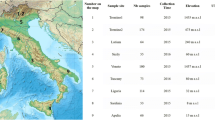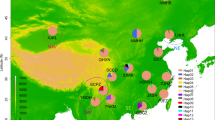Abstract
Allozyme and mitochondrial gene diversities were estimated in house flies, Musca domestica L. (Diptera: Muscidae), sampled in Iowa, USA; Berkshire, England; and Kudang, The Gambia. Comparison of genomic allele frequencies among the three populations indicated small differences between the English and American samples but very large distances between English or American and the African. The F ST statistic was 0.65 ± 0.09 for allozymes. Pairwise F ST was 0.14 between the English and the American samples; F ST was 0.65 between the African population and the English and American. Mitochondrial variation in the same flies was assessed by SSCP methods which revealed nine haplotypes, none of which were shared in common. F ST was 0.637 for the mitochondrial haplotypes. The research indicates greatly restricted gene flow between Africa and the temperate regions.
Similar content being viewed by others
REFERENCES
Black, W. C., and Du Teau, N. M. (1997). RAPD-PCR and SSCP analysis for insect population genetic studies. In Crampton, J. M., Beard, C. B., and Louis, C. (eds.), Molecular Biology of Insect Disease Vectors: A Methods Manual, Chapman & Hall, London, pp. 361–383.
Excoffier, L., Smouse, P. E., and Quattro, J. M. (1992). Analysis of molecular variance inferred from metric distances among DNA haplotypes: Application to human mitochondrial DNA restriction data. Genetics 131: 479.
Greenberg, B. (1971). Flies and Disease.Vol.1.Ecology, Classification, and Biotic Associations, Princeton University Press, Princeton, NJ.
Grubel, P., Huang, L., Masubuchi, N., Stutzenberger, F. J., and Cave, D. R. (1998). Detection of Helicobacter pylori DNA in houseflies (Musca domestica) on three continents. Lancet (Br.ed.) 352: 788.
Hale, L. R., and Singh, R. S. (1991). A comprehensive study of genic variation in natural populations of Drosophila melanogaster. IV. Mitochondrial DNA variation and the role of history vs. selection in the genetic structure of geographic populations. Genetics 129: 103.
Hulley, P. E. (1979). Relationships of the Musca domestica subspecies calleva and curviforceps (Diptera: Muscidae) in Rhodesia. Syst.Entomol. 4: 223.
Krafsur, E. S. (1985). Age composition and seasonal phenology of house fly (Diptera: Muscidae) populations. J.Med.Entomol. 22: 515.
Krafsur, E. S., Helm, J., and Black, W. C., IV (1992). Genetic diversity at electrophoretic loci in the house fly, Musca domestica L. Biochem.Genet. 30: 317.
Nei, M. (1987). Molecular Evolutionary Genetics, Columbia University Press, New York.
Paterson, H. E. (1956). Status of the two forms of housefly occurring in South Africa. Nature 178: 928.
Paterson, H. E. (1964). Population genetic studies in areas of overlap of two subspecies of Musca domestica L. In Davis, D. H. S., (ed.), Ecological Studies in Southern Africa.Monographiae Biologicae 14: 244–254. W. Junk, The Hague
Pont, A. C. (1991). A review of the Fanniidae and Muscidae (Diptera) of the Arabian Peninsula. In Buttiker, W., and Krupp, F. (eds.), Fauna of Saudi Arabia, Vol. 12, National Commission for Wildlife Conservation and Development, Riyadh.
Quarterman, K. D., Mathis, W., and Kilpatrick, J. W. (1954). Urban fly dispersal in the area of Savannah, Georgia. J.Econ.Entomol. 47: 405.
Roerhdanz, R. L. (1993). Genome organization and restriction site map of the mitochondrial DNA of the housefly (Musca domestica). Genome 36: 367.
Saccà, G. (1964). Comparative bionomics in the genus Musca. Annu.Rev.Entomol. 9: 34.
Schneider, S., Kueffer, J.-M., Roessli, D., and Excoffier, L. (1997). Arlequin ver.1.1: A Software for Population Genetic Data Analysis, Genetics and Biometry Laboratory, University of Geneva, Geneva.
Simon, C., Frati, F., Beckenbach, A., Crespi, B., Liu, H., and Flook, P. (1994). Evolution, weighting, and phylogenetic utility of mitochondrial gene sequence and a compilation of conserved polymerase chain reaction primers. Ann.Entomol.Soc.Am. 87: 651.
Skidmore, P. (1985). The Biology of the Muscidae of the World, Series Entomologica Vol. 29, Dr. W. Junk, Dordrecht.
Swofford, D. L., and Selander, R. B. (1981). BIOSYS-1: A FORTRAN program for the comprehensive analysis of electrophoretic data in population genetics and systematics. J.Hered. 72: 281.
Weir, B. S., and Cockerham, C. C. (1984). Estimating F-statistics for the analysis of population structure. Evolution 38: 1358.
West, L. S. (1951). The Housefly, Cornell University Press, Ithaca, NY.
Wright, S. (1978). Evolution and the Genetics of Populations, Vol.4.Variability Within and Among Natural Populations, University of Chicago Press, Chicago.
Author information
Authors and Affiliations
Rights and permissions
About this article
Cite this article
Krafsur, E.S., Bryant, N.L., Marquez, J.G. et al. Genetic Distances Among North American, British, and West African House Fly Populations (Musca domestica L.). Biochem Genet 38, 275–284 (2000). https://doi.org/10.1023/A:1002010632647
Issue Date:
DOI: https://doi.org/10.1023/A:1002010632647




